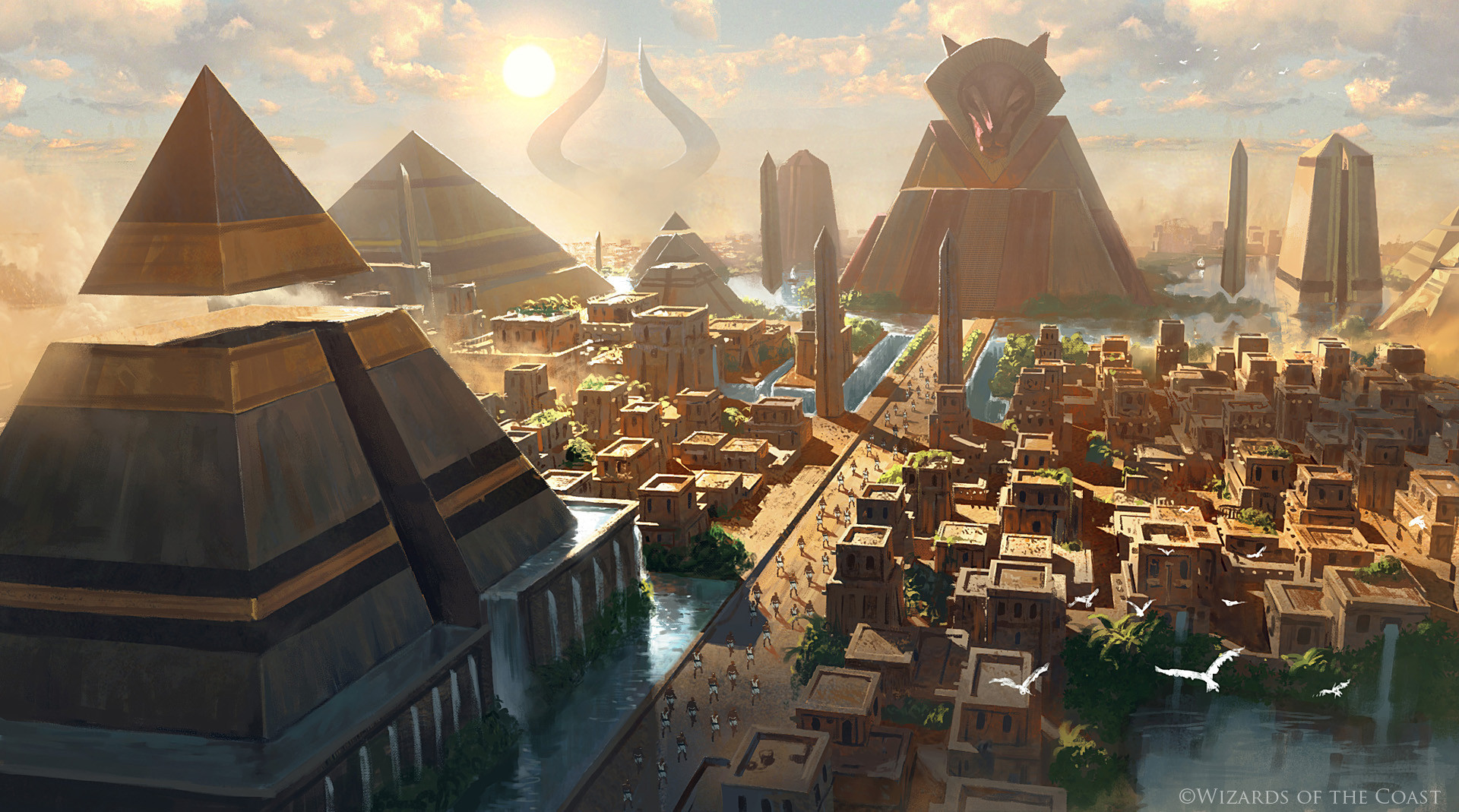

Revisit Magic: the Gathering's Ancient Egypt-inspired plane of Amonkhet in this guide for the world's greatest roleplaying game
Credits
- Designer:
- Gabe Rodriguez, /u/letterephesus
- Logo:
- Wizards of the Coast
- Cover Art:
- Greg Rutkowski
Artist Credits:
Aaron Miller, Anna Steinbauer, Aleksi Briclot, Bastien L. Deharme, Ben Maier, Daarken, Greg Rutkowski, Joseph Meehan, Ryan Alexander Lee, Tomasz Jedruszek, Viktor Titov, Yeong Hao Han
- The following resources provided material and inspiration:
- The MTG Wiki
- The orignal Plane Shift: Amonkhet
- The Amonkhet Player's Guide
- Magic: the Gathering cards from the Amonkhet and Hour of Devastation sets
- Technical Resources:
- Detect Balance Spreadsheet for Custom Races by u/jwbjerk
- D&D Watercolor Stains by Jared Ondricek
- Planeshifted Guides:
- Visit new Magic: the Gathering planes in D&D with these feature-length guides:
- New Phyrexia, inspired by biomechanical horror
- The Streets of New Capenna; inspired by 1920's America
- The Ten Realms of Kaldheim; inspired by Norse mythology
- Kamigawa: Neon Dynasty; inspired by Japanese culture and cyberpunk
- The Throne of Eldraine, inspired by Grimm fairy tales and Arthurian legend
Support Planeshifted Guides
This is 100% free fan content. You can show your support for the Planeshifted Guides project through my Patreon, or by buying me a coffee. Thank you!
Supporters
Huge thank you to all my supporters, you guys rock!
A.J., Antoine Polignone, Charles Reed, Cole McNutt, Donovan Lowell, Douglas Burtt, FER, Jonathan Cowley, Joseph Joffe, Justin Finley, Lex Raine, Mark F., Radek, ReaperTheWolf, TallguyZin
Contents
PDF Link
Click Here to view and download the latest PDF version (0.4).
Changelog
- Version 1.1c
- Updated support links
- Version 1.1b
- Fixed broken image links
- Version 1.1
- Fixed commit to memory spell (thank you /u/ErzIgel)
- Version 1.0
- Public Release
- Added PDF link
- Version 0.4
- Added a back cover (I'm experimenting with this, idk if I like it enough to use it in main books)
- Version 0.3
- Updated human race to Planeshifted standard
- Added description snippets to races
- Minor technical language updates
- Version 0.2
- Updated front cover
- Added Magic Items section
- Version 0.1
- Early access release
A Planshifted Return to Amonkhet is unofficial Fan Content permitted under the Fan Content Policy. Not approved/endorsed by Wizards. Portions of the materials used are property of Wizards of the Coast. ©Wizards of the Coast LLC.
This document was created solely for private use. All rights are retained by the owners of trademarks and copyrights of the content within this document. This document, in part or whole, cannot be reproduced for the intent of retail sale or personal gain except by those said interested parties or by others with legal, written consent by said parties.
About this Book
This book is a quick supplemental guide to be used with Plane Shift: Amonkhet, which provides rules and options for playing Dungeons & Dragons 5th edition in the Amonkhet setting from Magic: the Gathering. This book provides updated character options and a selection of new spells.
![]() Races
Races
At 1st level, you choose your character's race. This section presents updated playable races for this setting. Plane Shift: Amonkhet provides information to help you understand your character's place in the world.
When you create a character for a campaign or adventure set on the plane of Amonkhet, you choose from one of the race options presented here, and follow these additional rules during character creation.
Ability Score Increases
When determining your ability scores, you increase one of those scores by 2 and increase a different score by 1, or you increase three different scores by 1. You follow this rule regardless of the method you use to determine the scores, such as rolling or point buy.
Your class's "Quick Build" section offers suggestions on which scores to increase. You're free to follow those suggestions or to ignore them. Whichever scores you decide to increase, none of the scores can be raised above 20.
Languages
Your character can speak, read, and write Common and one other language that you and your DM agree is appropriate for the character. The languages in Amonkhet that a character might speak are listed below.
Amonkhet Languages
| Language | Typical Speakers |
|---|---|
| Aven | Aven |
| Draconic | Angels |
| Common | Anyone |
| Fiendish | Demons |
| Khenra | Khenra |
| Minotaur | Minotaurs |
| Naga | Naga |
| Sphinx | Sphinxes |
Creature Type
Every creature in D&D, including every player character, has a special tag in the rules that identifies the type of creature they are. Most player characters are of the Humanoid type. A race in this section tells you what your creature type is.
Here's a list of the game's creature types in alphabetical order: Aberration, Beast, Celestial, Construct, Dragon, Elemental, Fey, Fiend, Giant, Humanoid, Monstrosity, Ooze, Plant, Undead. These types don’t have rules themselves, but some rules in the game affect creatures of certain types in different ways. For example, the cure wounds spell doesn’t work on a Construct or an Undead.
Age
The typical life span of a player character in the D&D multiverse is about a century, assuming the character doesn’t meet a violent end on an adventure.
Height and Weight
Player characters, regardless of race, typically fall into the same ranges of height and weight that humans have in our world. If you’d like to determine your character’s height or weight randomly, consult the Random Height and Weight table in the Player’s Handbook, and choose the row in the table that best represents the build you imagine for your character.
Proficiencies
Some races and subraces grant proficiencies. These proficiencies are usually cultural, and your character might not have any connection with the culture in question or might have pursued different training. You can replace each of those proficiencies with a different one of your choice, following the restrictions on the Proficiency Swaps table.
Proficiency Swaps
| Proficiency | Replacement Proficiency |
|---|---|
| Skill | Skill |
| Armor | Simple/Martial weapon or tool |
| Martial weapon | Simple/Martial weapon or tool |
| Simple weapon | Simple weapon or tool |
| Tool | Simple weapon or tool |

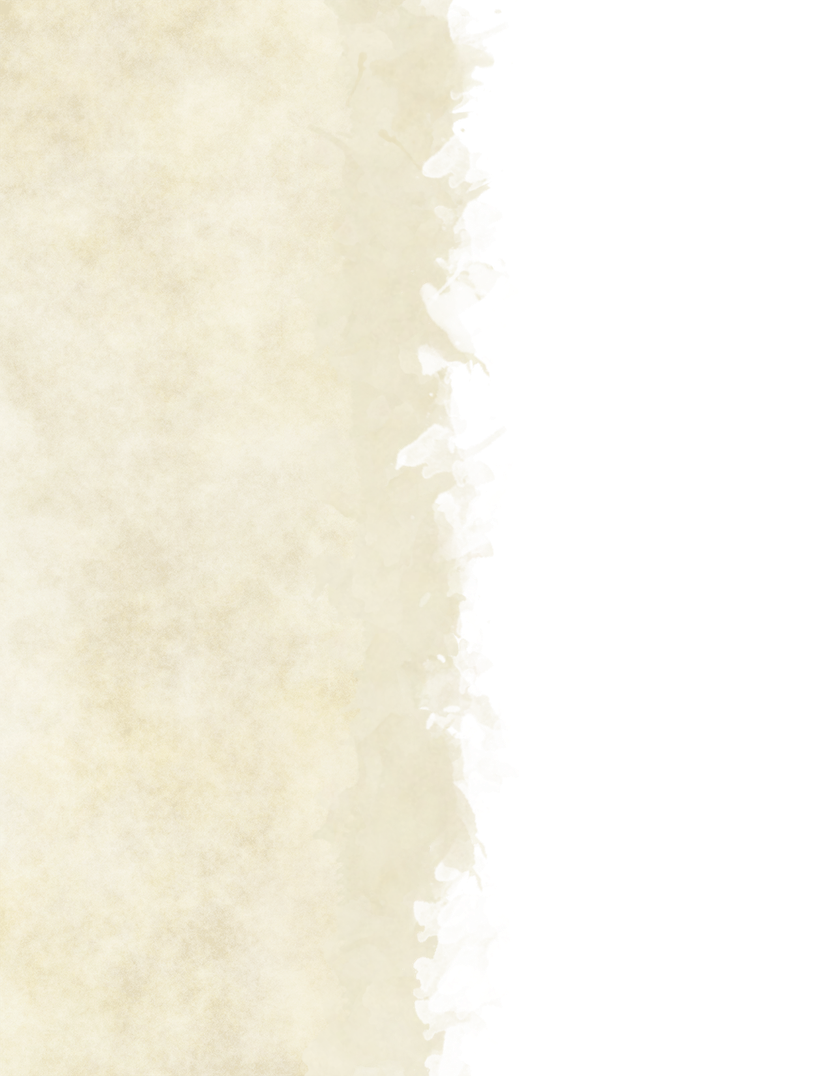
 Bastien L.Deharme
Bastien L.Deharme
@deharme
Angel
Angels are celestial creatures that reflect the powerful dragon planeswalker Nicol Bolas. They keep order in the city of Naktamun and enact the will of the gods. You can learn more about angels in Plane Shift: Amonkhet.
![]() Angel Traits
Angel Traits
You have the following racial traits.
Creature Type. You are a Celestial.
Size. You are Medium.
Speed. Your walking speed is 30 feet.
Blessing of the God-Pharaoh. You know the light cantrip. Starting at 5th level, you can cast the tomb of disgrace* spell with this trait. Once you cast it with this trait, you can't do so again until you finish a long rest. You can also cast it using any spell slots you have of 3rd level or higher.
Intelligence, Wisdom, or Charisma is your spellcasting ability for these spells when you cast them with this trait (choose when you select this race).
Flight. Because of your wings, you have a flying speed equal to your walking speed. You can't use this flying speed if you're wearing medium or heavy armor.
* The tomb of disgrace spell appears on page 14.
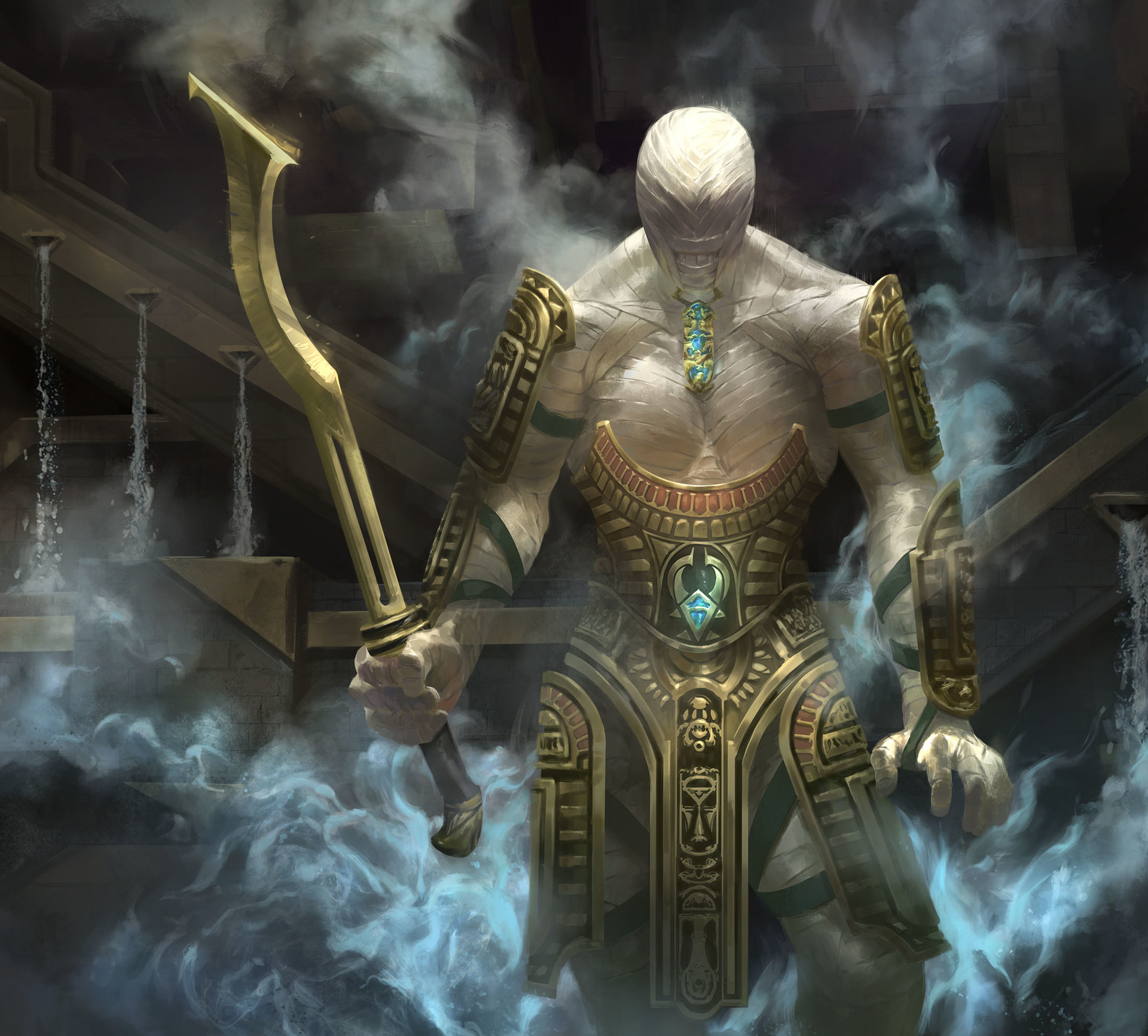

 Yeong Hao Han
Yeong Hao Han
@fooyee
Anointed
Anointed are servile mummies, the dead who did not fully complete the trials of the gods but are able to serve the city of Naktamun in their afterlife. You can learn more about anointed in Plane Shift: Amonkhet.
![]() Anointed Traits
Anointed Traits
You have the following racial traits.
Creature Type. You are an Undead.
Size. You are Medium.
Speed. Your walking speed is 30 feet.
Deathless Nature. You have resistance to poison damage and immunity to disease, and you have advantage on saving throws you make to avoid or end the poisoned condition on yourself. You don't need to eat, drink, or breathe.
Relentless Endurance. When you are reduced to 0 hit points but not killed outright, you can drop to 1 hit point instead. Once you use this trait, you can't do so again until you finish a long rest.
Sleepless. You don't need to sleep, and magic can't put you to sleep. You remain conscious during a long rest, though you must still refrain from strenuous activity to gain the benefit of the rest.
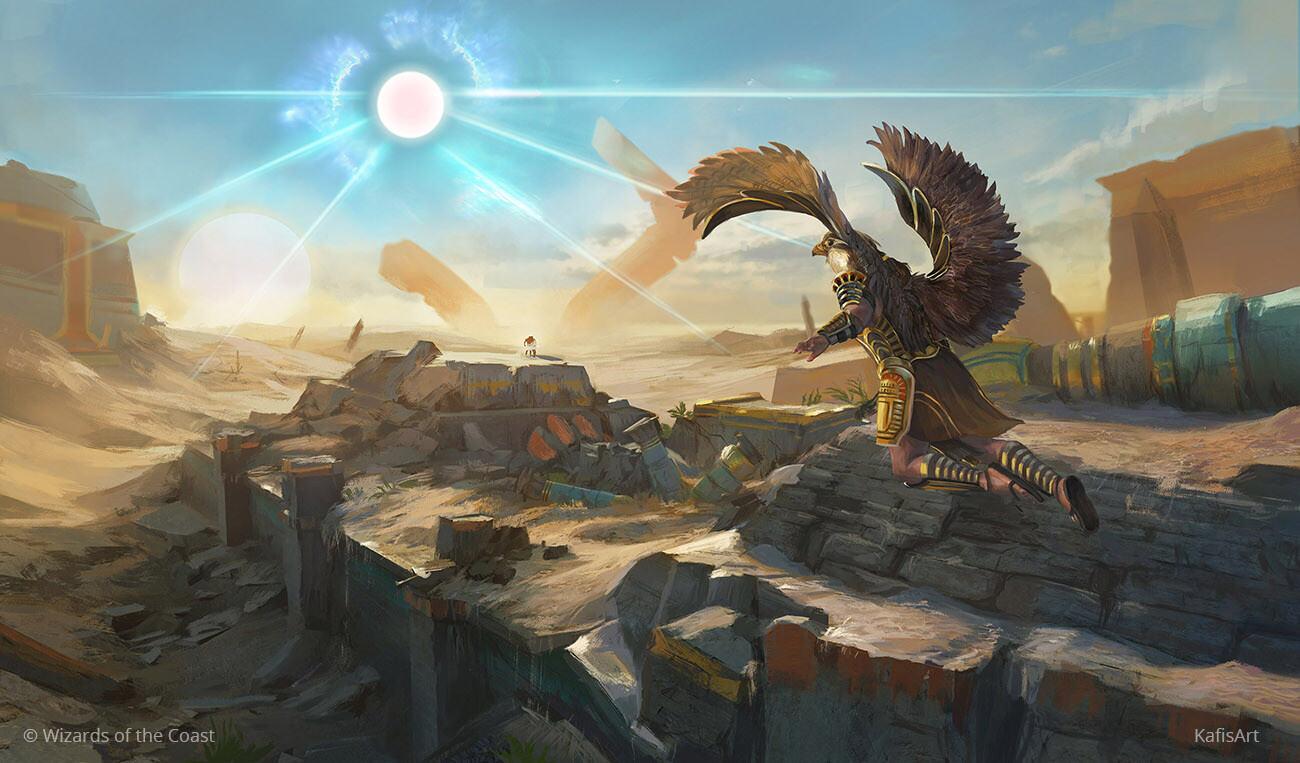

 Aaron Miller
Aaron Miller
@aaronbmiller
Aven
Aven are winged humanoids who bear the heads of birds—falcons or ibises. You can learn more about aven in Plane Shift: Amonkhet.
![]() Aven Traits
Aven Traits
You have the following racial traits.
Creature Type. You are a Humanoid.
Size. You are Medium.
Speed. Your walking speed is 30 feet.
Beak. You have a beak that you can use to make unarmed strikes. When you hit with it, the strike deals 1d6 + your Strength modifier piercing damage, instead of the bludgeoning damage normal for an unarmed strike.
Flight. Because of your wings, you have a flying speed equal to your walking speed. You can't use this flying speed if you're wearing medium or heavy armor.
Aven Subrace. You gain an additional benefit based on one of the following options (choose when you select this race):
- Falcon-headed. You have proficiency in the Perception skill, and you have advantage on Wisdom (Perception) checks that rely on sight. In conditions of clear visibility, you can make out details of even extremely distant creatures and objects as small as 2 feet across.
- Ibis-headed. You have proficiency with two of the following skills of your choice: Arcana, History, Nature, or Religion. In addition, you can speak, read, and write an additional language of your choice.
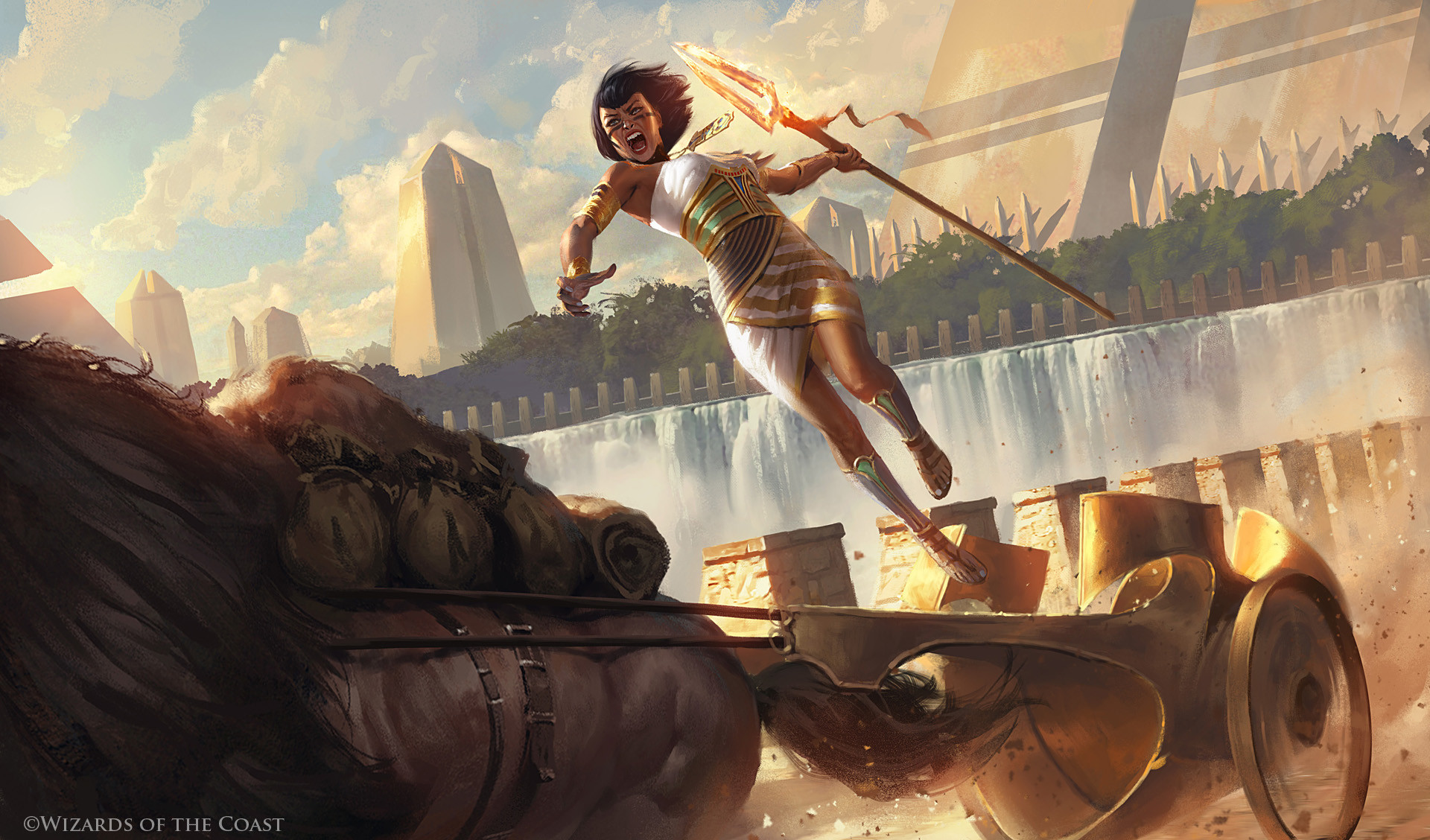

 Greg Rutkowski
Greg Rutkowski
@rutkowski
Human
Humans of Amonkhet are similar to their counterparts in other worlds. You can learn more about Amonkhet humans in Plane Shift: Amonkhet.
![]() Human Traits
Human Traits
You have the following racial traits.
Creature Type. You are a Humanoid.
Size. You are Medium.
Speed. Your walking speed is 30 feet.
Human Determination. When you make an attack roll, an ability check, or a saving throw, you can do so with advantage. You can use this trait a number of times equal to your proficiency bonus, and you regain all expended uses when you finish a long rest.
Skills. Humans have a wide range of natural talents. You have proficiency in one skill of your choice and with one tool of your choice.
Variant Traits
If your campaign uses the optional feat rules found in the Player's Handbook, your Dungeon Master might allow these variant traits, which replace your Human Determination and Skills trait.
Resourceful. Whenever you finish a long rest, you are given inspiration, using the rules for inspiration provided in the Player's Handbook.
Feat. You gain one of the following feats from the Player's Handbook: Alert, Healer, Lucky, Magic Initiate, Savage Attacker, Skilled, or Tough.
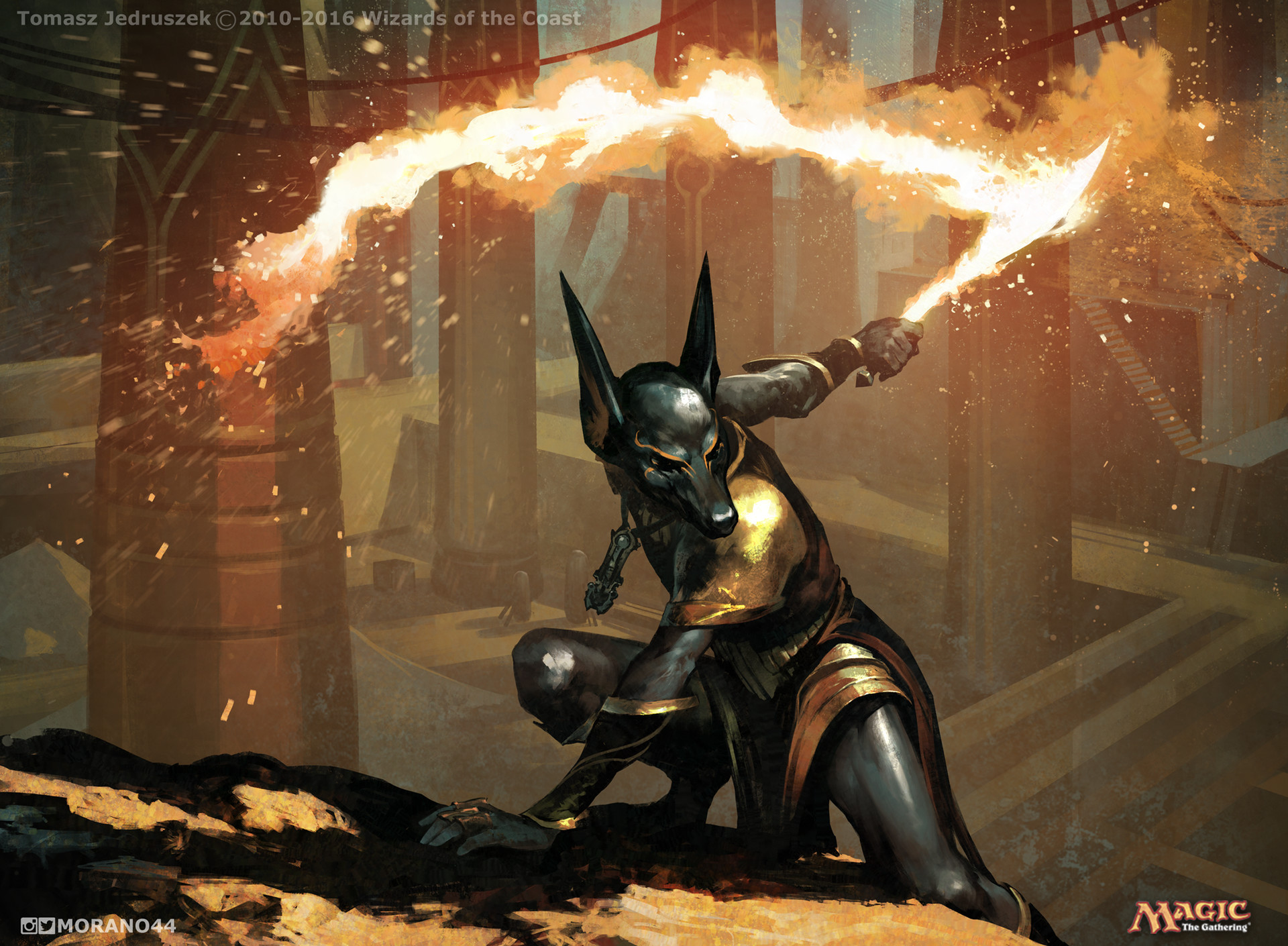

 Tomasz Jedruszek
Tomasz Jedruszek
@morano
Khenra
Khenra are lithe jackal humanoids, often born as twins. You can learn more about khenra in Plane Shift: Amonkhet.
![]() Khenra Traits
Khenra Traits
You have the following racial traits.
Creature Type. You are a Humanoid.
Size. You are Medium.
Speed. Your walking speed is 30 feet.
Bite. You can use your fanged maw to make unarmed strikes. When you hit with it, the strike deals 1d6 + your Strength modifier piercing damage, instead of the bludgeoning damage normal for an unarmed strike.
Keen Hearing and Smell. You have proficiency in the Perception skill, and you have advantage on any Wisdom (Perception) check that relies on hearing or smell.
Khenra Twin. You gain an additional benefit based on one of the following options (choose when you select this race):
- Twin Tactics. You have advantage on attack rolls against a creature if at least one of your allies is within 5 feet of the creature and the ally isn't incapacitated.
- Twinless. You are immune to the frightened condition.
Twin-Dependent
If you lose your khenra twin during the course of your campaign, your DM may allow you to replace your Twin Tactics trait with the Twinless trait, and vice versa if you reunite with your twin.
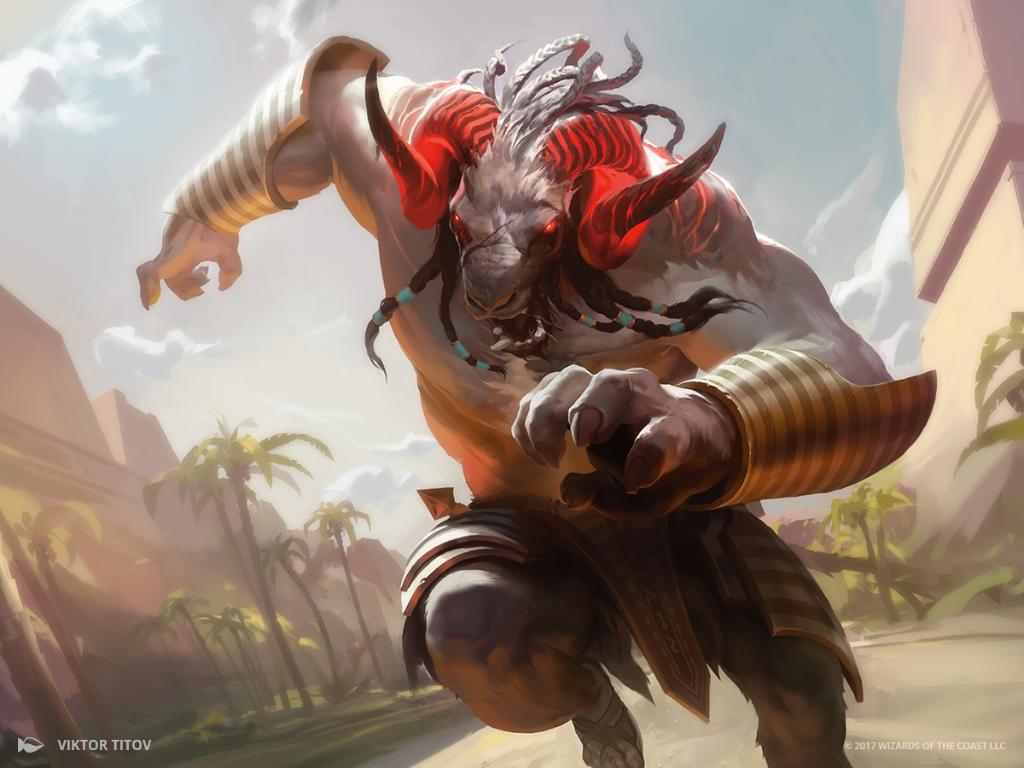

 Viktor Titov
Viktor Titov
@viktortitov
Minotaur
Minotaur are hulking oxen humanoids. Amonkhet minotaur have the innate power to call flame. You can learn more about minotaur in Plane Shift: Amonkhet.
![]() Minotaur Traits
Minotaur Traits
You have the following racial traits.
Creature Type. You are a Humanoid.
Size. You are Medium.
Speed. Your walking speed is 30 feet.
Flaming Fury. When you damage a creature with your Horns or a weapon attack, you can cause the attack to deal an additional amount of fire damage equal to your proficiency bonus.
You can use this trait a number of times equal to your proficiency bonus, regaining all expended uses when you finish a long rest, and you can use it no more than once per turn.
Horns. You can use your horns to make unarmed strikes. When you hit with them, the strike deals 1d6 + your Strength modifier piercing damage, instead of the bludgeoning damage normal for an unarmed strike.
Ram. If you move at least 30 feet straight toward a target and then hit it with your Horns on the same turn, the target must succeed on a Strength saving throw with a DC equal to 8 + your proficiency bonus + your Strength modifier or be knocked prone or pushed 5 feet away from you (your choice).


 Daarken
Daarken
@daarken
Naga
Naga are snake-like humanoids. They lack lower limbs, instead having a long serpentine body. You can learn more about naga in Plane Shift: Amonkhet.
![]() Naga Traits
Naga Traits
You have the following racial traits.
Creature Type. You are a Humanoid.
Size. You are Medium.
Speed. Your walking speed is 30 feet.
Bite. You can use your fanged maw to make unarmed strikes. When you hit with it, the strike deals 1d6 + your Strength modifier piercing damage, instead of the bludgeoning damage normal for an unarmed strike.
Blindsight. You can perceive your surroundings within 10 feet of you without relying on sight. You can't detect Constructs or Undead this way.
Poison Bite. As an action, you can make a special unarmed strike with your Bite. If the strike hits, it deals its normal damage, and the target must succeed on a Constitution saving throw against a DC equal to 8 + your Constitution modifier + your proficiency bonus or or be poisoned until the start of your next turn.
You can use this trait a number of times equal to your proficiency bonus, and you regain all expended uses when you finish a long rest.
Serpentine Build. You can use your serpentine body to grapple a creature while leaving your hands free. You have advantage on ability checks you make to initiate a grapple this way.
Shed Skin. As a bonus action, you can end one condition on yourself from among blinded, deafened, grappled, paralyzed, poisoned, or restrained. Once you use this trait, you can't do so again until you finish a long rest.
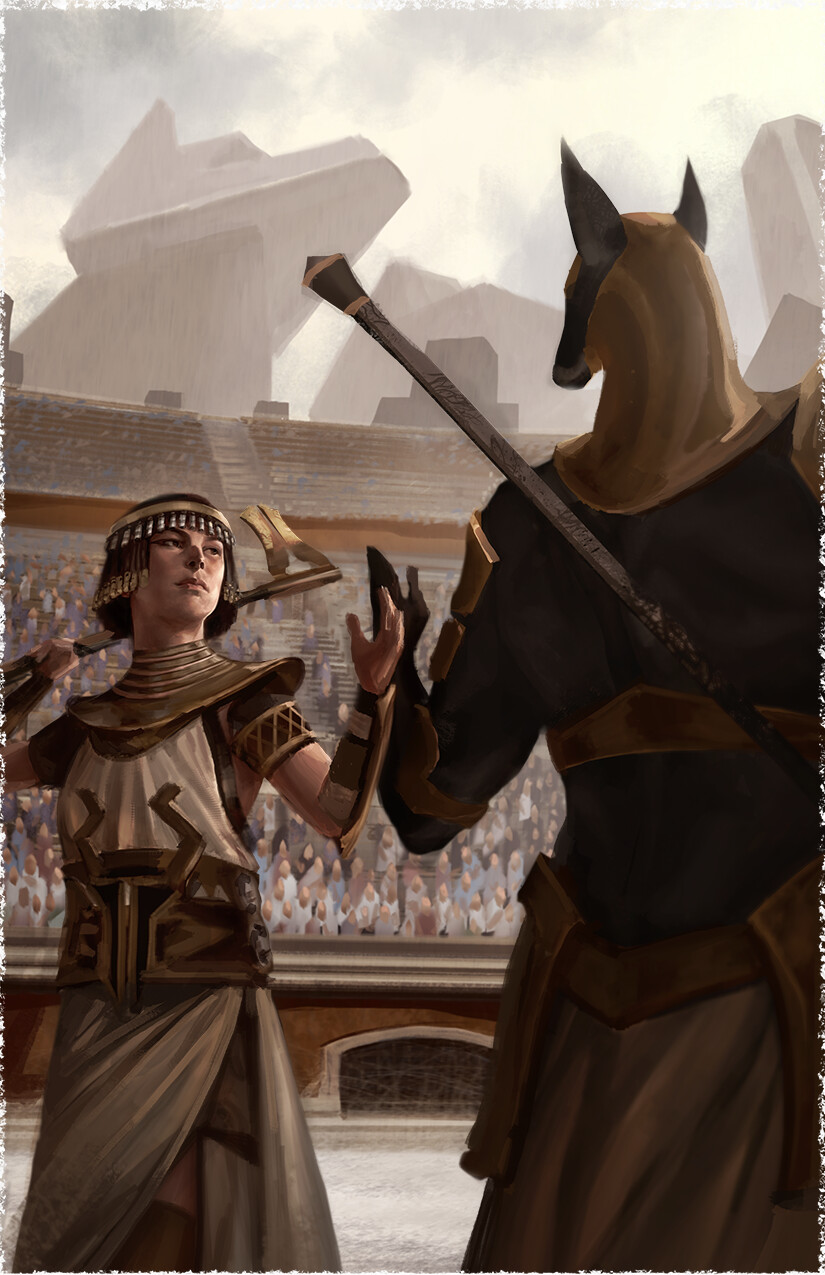

 Ryan Alexander Lee
Ryan Alexander Lee
@ryanleeart
![]() Backgrounds
Backgrounds
This section presents three sample backgrounds you can choose from to reflect a character from Amonkhet. The backgrounds in this section provide features, proficiencies, and equipment. This section also presents suggestions for adapting some of the backgrounds from the Player's Handbook to tie them more closely to Amonkhet.
Anointer
As an anointer, you have studied under the priests of Naktamun and learned the ancient process of mummification of the honored dead, the process used to create the anointed undead servants of the city.
- Skill Proficiencies: Arcana, Medicine
- Tool Proficiencies: Embalming tools, Weaver's tools
- Equipment: Embalming tools, a set of robes, and a belt pouch containing 10gp
Feature: Anointed
You have acquired the service of an anointed servant. It uses the zombie stat block. The servant acts independently of you, but treats you as an ally. The servant can perform mundane tasks for you, but it will not fight for you, will not follow you into obviously dangerous areas (such as dungeons), and will leave if it is frequently endangered or abused.
Embalming Tools
Embalming tools are a set of artisan's tools. If your campaign uses the Tool Proficiencies rules found in Xanathar's Guide to Everything, embalming tools have the following description:
Embalming tools enable a character to prepare a body for mummification and burial.
Components. Embalming tools include salts, a metal hook, knives, canopic jars, thread, needles, and scraps of linen.
Arcana, Religion. Proficiency with embalming tools aids you when determining the nature and origin of Undead creatures.
Medicine. This tool proficiency grants additional insight when treating life-threatening wounds.
Prepare Anointed. As part of a long rest, you can use embalming tools to prepare the corpse of one Large or smaller creature. The creature is protected against the Curse of Wandering, and if it becomes Undead, it becomes a docile anointed.
Embalming Tools
| Activity | DC |
|---|---|
| Determine an Undead's nature | 10 |
| Preserve organic material | 15 |
| Treat a lingering injury | 15 |
Charioteer
Chariots are used both to travel the desert sands and to engage in the trials. You have practiced this art extensively, and any crop would cherish having one with your skills among their ranks.
- Skill Proficiencies: Acrobatics, Perception
- Tool Proficiencies: Vehicles (land), Navigator's tools
- Equipment: A whip, a chariot, a draft horse, 10 days of animal feed, and a set of traveler's clothes.
Feature: Chariot Driver
You have advantage on any Wisdom (Animal Handling) check, Dexterity-based ability check, or Dexterity saving throw you make to maintain control of a chariot or a creature pulling it.
Chariots
Chariots and the creatures pulling them work like controlled mounts, as described in the mounted combat rules in the Player's Handbook, but with the following differences:
- Mounting or dismounting a chariot costs you 5 feet of movement, rather than a number of feet equal to half your speed.
- Being mounted on a chariot grants you half cover.
- A chariot's speed is equal to the speed of the slowest creature pulling it.
- If multiple creatures are pulling the chariot, they all act on the same initiative, and they must take the same action on their turn.
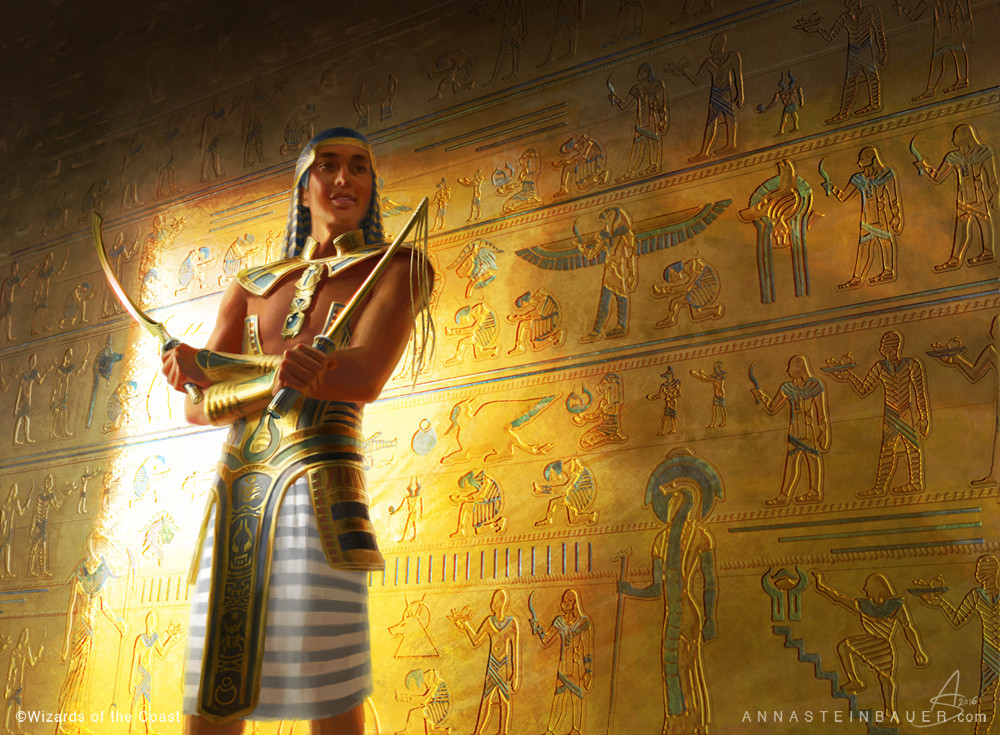

 Anna Steinbauer
Anna Steinbauer
@depingo
Excavator
The deserts of Amonkhet, and in particular the Ramunap Broken Lands, hold many secrets of civilizations long lost, and many treasures worth uncovering. You have dedicated your life to traveling the wastes in search of these secrets.
- Skill Proficiencies: History, Survival
- Tool Proficiencies: Cartographer's tools or Navigator's tools
- Languages: One of your choice
- Equipment: A scroll case, a bullseye lantern, a miner's pick, a shovel, a two-person tent, a piece of lazotep ore, a set of traveler's clothes, and a belt pouch containing 5gp.
Feature: Desert Secrets
When you enter a ruin or dungeon, you can correctly ascertain its original purpose and determine its builders. In addition, you can determine the monetary value of art objects more than a century old.
Lazotep
Lazotep is a magical blue mineral found only on Amonkhet, mined from deep below the sands. It is a channel for blue mana, giving it antimagic properties. It can be worked into medium or heavy armor.
The lazotep version of a suit of armor costs 1,000gp more than the normal version. While wearing lazotep armor, you have the following trait.
Magic Resistance. You have advantage on saving throws against spells, and spell attack rolls made against you have disadvantage.
Adapting Backgrounds
The following existing backgrounds found in the Player's Handbook can be adapted to better represent characters from Amonkhet.
Diviner (Hermit)
On Amonkhet, a diviner spends their time studying the sands, hoping to unlock the secrets of the future. Your Discovery is likely a great revelation about events soon to pass.
Scribe (Sage)
A scribe of Naktamun records events and transpondences, and spends a great deal of time at the monuments to the gods. Your Researcher feature will likely take you to one of these monuments.
Hekma Sentinel (Soldier)
The Hekma is the great wall that surrounds the city of Naktamun, separating it from the desert and keeping the citizens safe. The Hekma Sentinels are guards who patrol the walls, defending it from abominations, dissenters, and other threats.
![]() Spells
Spells
The following section presents spells available to spellcasters in Amonkhet. The Spells table shows which class spell lists the spells appear on, as well as that spell's level and school of magic. With your DM's permission, these spells might be available to you even if they aren't on your class spell list. (The Artificer class is presented in Tasha's Cauldron of Everything.)
Spells
| Level | Spell | School | Classes |
|---|---|---|---|
| C | Commit to Memory | Div. | Artificer, Wizard |
| C | Pull from Tomorrow | Con. | Artificer, Wizard |
| 1st | Lay Bare the Heart | Div. | Bard, Sorcerer, Warlock, Wizard |
| 3rd | Supernatural Stamina | Nec. | Cleric, Paladin |
| 3rd | Tomb of Disgrace | Nec. | Artificer, Cleric, Paladin |
| 4th | Dispossess | Abj. | Cleric, Paladin, Sorcerer, Warlock, Wizard |
| 4th | Hapatra's Mark | Abj. | Artificer, Cleric, Druid, Paladin, Ranger |
| 9th | Heaven to Earth | Con. | Cleric, Paladin, Sorcerer, Warlock, Wizard |
Commit to Memory
Divination cantrip
- Casting Time: 1 action
- Range: Self
- Components: S
- Duration: 1 month
This spell records complex information that you can see, such as a detailed map or a long sequence of symbols. Until the spell ends, you can use your action to create an illusory duplicate of the information recorded. If you cast this spell again before it ends, the first information recorded is lost.
Dispossess
4th-level Abjuration
- Casting Time: 1 action
- Range: 30 feet
- Components: V, S
- Duration: Concentration, up to 1 minute
You attempt to banish one Large or smaller object you can see within range to the space between the planes. If the object is being worn or carried by a creature, that creature must make a Wisdom saving throw. On a failed save, or if the object isn't being worn or carried, the object is banished until the spell ends, at which point the target reappears in the space it left or in the nearest unoccupied space if that space is occupied. Artifacts are unaffected by this spell.
At Higher Levels. When you cast this spell using a spell slot of 5th level or higher, you can target one additional object for each slot level above 4th.
Heaven to Earth
9th-level Conjuration
- Casting Time: 1 action
- Range: 120 feet
- Components: V, S, M (a shard of ice and a small flame)
- Duration: Instantaneous
You cause a meteoric mass of rock to plummet to the ground at a point you can see within range. Each creature in a 20-foot radius cylinder centered on that point must make a Dexterity saving throw. On a failed save, a creature takes 20d6 bludgeoning damage, is knocked prone, and is trapped beneath the rock. A trapped creature is restrained, and can use its action to make a Strength check against your spell save, freeing itself on a success. On a successful save, the creature takes half as much damage and doesn't fall prone or become trapped. The ground in the area becomes a crater of difficult terrain.
Structures and nonmagical objects that aren't being worn or carried within the spell's area also take damage. If part of a nonmagical structure would prevent the mass of rock from reaching the ground, that part of the structure is destroyed. An object that is completely within the spell's area is buried beneath the rock, requiring a successful Strength check against your spell save DC to unearth.
Hapatra's Mark
4th-level Abjuration
- Casting Time: 1 action
- Range: Self
- Components: V, S
- Duration: Concentration, up to 1 minute
A glowing tattoo of a coiled snake appears around your arm and lasts for the duration. Until the spell ends, you are immune to poison damage and the poisoned condition, you can't be the target of spells of 3rd level or lower, and you have advantage on saving throws against spells.
At Higher Levels. When you cast this spell using a spell slot of 5th level or higher, the spell blocks spells of one level higher for each slot level above 4th.
Lay Bare the Heart
1st-level Divination
- Casting Time: 1 action
- Range: 10 feet
- Components: V, S, M (a crocodile tooth)
- Duration: Instantaneous
You reach out to a creature you can see within range that has an Intelligence score of 4 or greater. The spell creates an illusion of the target's heart leaving their chest.
You learn the target's current emotional state. The target must succeed on a Charisma saving throw or you also learn the target's alignment and a flaw or secret about the target. Celestials, Fiends, and Undead automatically fail this saving throw.
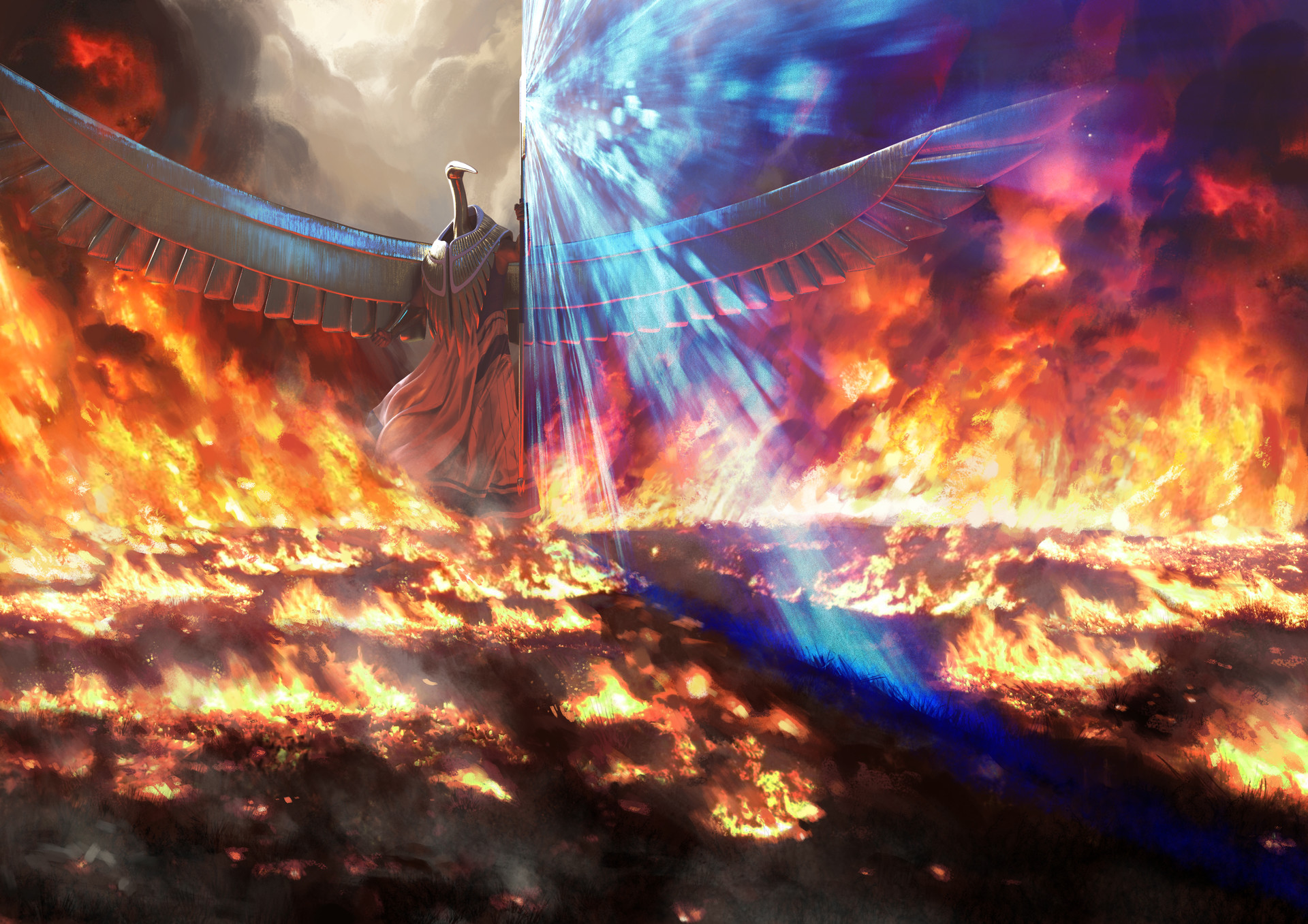

 Joseph Meehan
Joseph Meehan
@meehanjo
Pull from Tomorrow
Conjuration cantrip
- Casting Time: 10 minutes
- Range: Self
- Components: V, S, M (an hourglass)
- Duration: Instantaneous
You reach forward through time, pulling arcane energy from your future self. You regain one expended spell slot of 3rd level or lower. When you finish your next long rest, you immediately expend a spell slot of equivalent level.
If you cast this spell again before 24 hours have passed, it has no effect.
Supernatural Stamina
3rd-level Necromancy
- Casting Time: 1 reaction, which you take when you are hit by an attack
- Range: Self
- Components: V
- Duration: 1 round
A glowing mark of Bontu appears on your chest and lasts for the duration. Until the start of your next turn, the next time you are reduced to 0 hit points as the result of taking damage from an attack, you drop to 1 hit point instead. When the spell ends, your exhaustion level is reduced by 1.
Tomb of Disgrace
3rd-level Conjuration
- Casting Time: 1 action
- Range: 60 feet
- Components: V, S, M (a canopic jar)
- Duration: Concentration, up to 1 minute
You choose a Medium or smaller creature you can see within range and conjure a sarcophagus around it, which lasts for the duration. The target must succeed on a Dexterity saving throw or be trapped inside the sarcophagus. While trapped, the target is blinded and restrained and has full cover from attacks originating outside the sarcophagus. Likewise, creatures and objects outside the sarcophagus have full cover from the trapped target.
A trapped creature can use its action to make a Strength check against your spell save DC, ending the spell on a success. The sarcophagus can also be destroyed by dealing damage to it, ending the spell (AC 17; hp 20; damage threshold 10; immunity to poison and psychic damage).
If you concentrate on this spell for the full possible duration, the spell lasts until it is dispelled or until the sarcophagus is destroyed.

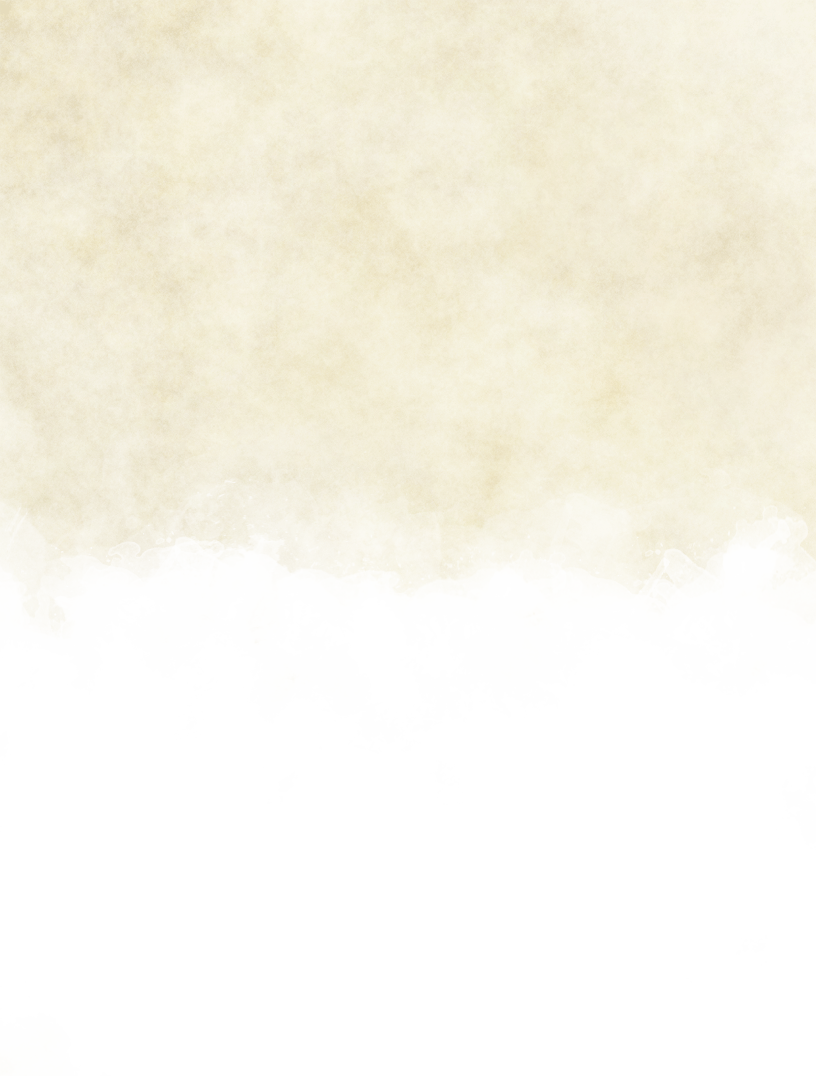
 Ben Maier
Ben Maier
@benmaierart
![]() Magic Items
Magic Items
This section presents some magic items that can be found in Amonkhet.
Traveler's Amulet
Wondrous Item, Very Rare (Requires Attunement)
This amulet depicts the jackal head of the god Hazoret. While you are outdoors during the day, you can hold the amulet towards the sun and cast the find the path spell from it at will.
Dagger of the Worthy
Weapon (Dagger), Rare (Requires Attunement)
You gain a +2 bonus to attack and damage rolls made with this magic weapon.
While the dagger is on your person, you can't be charmed or frightened.
Crook of Condemnation
Weapon (Lance), Legendary (Requires Attunement)
This crook is used by angels to strip initiates of their cartouches.
You gain a +2 bonus to attack and damage rolls made with this magic weapon.
Using this magic weapon, you have advantage on attack rolls you make as part of the Disarm action on your turn. You can also use the Disarm action to remove a cartouche from around a target's neck.
Option: Magic Cartouches
In Plane Shift: Amonkhet, cartouches have no magical properties, despite being magical in Magic: the Gathering's lore. To represent this magic, your DM might give cartouches the following properties:
Cartouche
Wondrous Item, Uncommon
A cartouche is a magical emblem awarded to initiates for each trial of the gods they complete. They are also used to control both the anointed mummies and dissidents.
Anointing. If you die while wearing a cartouche, you are protected from the curse of wandering. A creature with proficiency with embalming tools can turn you into an anointed as a 1-hour ritual. At the end of the ritual, you return to life with all your hit points as an anointed. You replace your racial traits with those of the anointed race.
Control Magic. As an action while holding the cartouche, you can attempt to wrestle it around the neck of a creature that is hostile to you. Make a Strength (Athletics) contested by the target's Strength (Athletics) or Dexterity (Acrobatics) (their choice). If you succeed, the cartouche is placed around the target's neck.
At the start of each of its turns while the cartouche is around its neck, a non-Undead creature must succeed on a DC 13 Constitution saving throw or be paralyzed until the start of its next turn.
An Undead creature with a cartouche placed around its neck by you is charmed by you until the cartouche is removed. When the cartouche is removed, the Undead takes 6d6 force damage.
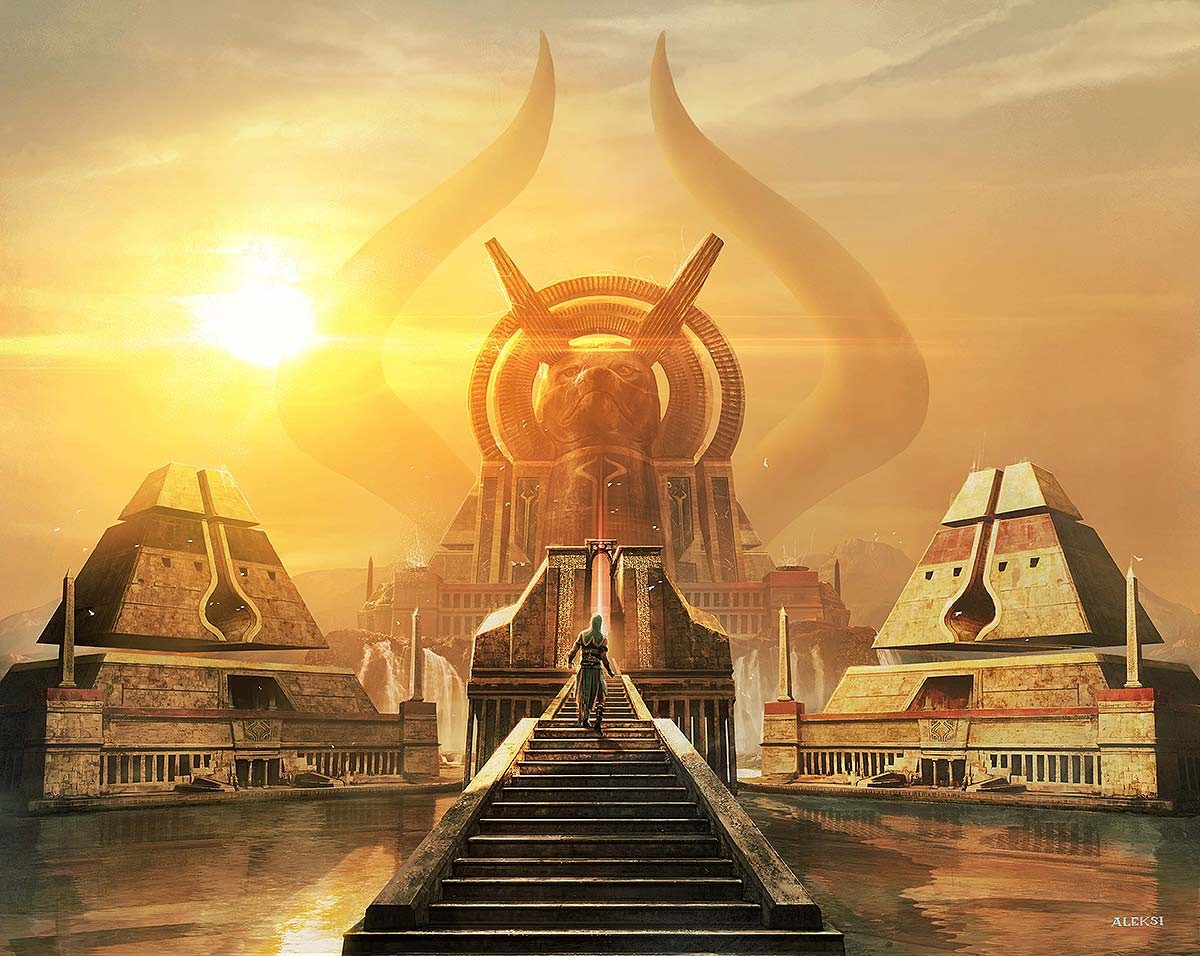
 Aleksi Briclot
Aleksi Briclot
@aleksi
Rise Among the Worthy
Huge thank you to all of my supporters and my personal play group, and to James Wyatt for his work on the original Plane Shift supplements.
This supplement is 100% free fan content permitted under the Fan Content Policy. Not approved/endorsed by Wizards. Portions of the materials used are property of Wizards of the Coast. ©Wizards of the Coast LLC.
If you'd like to help support more Magic: the Gathering planes homebrewed into D&D, consider supporting me on Patreon, or buying me a coffee.
For use with the fifth edition Player's Handbook, Monster Manual, Dungeon Master's Guide, and Plane Shift: Amonkhet supplement

Backgrounds
Scavenger (Urchin)
Servant
Cultivator (Folk Hero)
Ritualist (Acolyte)
Spells
Djeru's Resolve
Dreamsteal
Forsake the Worldly
Censor
Silence but single target
Scarab Feast
Magma Spray
Sandblast
Unsummon
Like dispel magic but specifically for summoned creatures